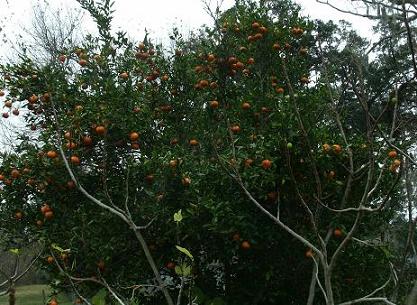
Having access yet again to an abundance of tangerines (two trees have produced heavily now for the past five years or so), I decided to experiment and see what I could do with them besides eating them fresh from the trees or juicing them. Tangerines, according to the online source Wikipedia (which cites the Oxford English Dictionary), are named such due to having been a citrus fruit commonly grown in the region of Tangiers. That article, besides listing key vitamins, minerals, and other nutritional constituents, cites research which identifies a flavanoid, called nobiletin, in tangerine peels "that not only prevents obesity in mice, but also offers protection against type 2 diabetes, and even atherosclerosis." Tangerine peel also contains a substance called Salvestrol Q40 which has been reported to kill "certain human cancer cells." Dried tangerine peels are popular ingredients in Sichuan cuisine. Another use for peels is as a confection, and so I have been making candied tangerine peels a lot lately.

Candied tangerine peels are very easy to make. To do so, use the peels of about six large tangerines. Because tangerines peel rather irregularly, you can simply use the "scraps." (Large pieces of peels can be cut to 1/4 to 1/2 inch strips.)
With tangerines you do not need to remove any or much of the white inner-peel (the pith). Blanching the peels in the first stage of preparation will get rid of any bitterness. When one makes candied orange, lemon, lime, or grapefruit peel, one needs to remove the pith to prevent bitterness. Here's how I make mine:
Ingredients:
peels from about six tangerines
one cup sugar
water
Place the tangerine peel pieces and strips in a sauce pan (I use a Corning Visions one-quart pan). Add water until it covers the peels. Bring the water to a boil and heat the peels for about twenty minutes. (You can turn down the heat as needed to prevent the pot boiling over, but keep a steady boil so that you can occasionally stir around the peels, so that all cook evenly and none stick to the bottom of the pan. They should start to have a translucent look at the end of twenty minutes.
Next, remove the pan from the burner and pour off (and discard) the water. Let the peels cool and dry. (This may help them to absorb the sugar water in the next step.)
Now, cover the peels with about a cup of granulated sugar (or an amount that equals the bulk of the peels). Add about the same amount of water. (Thus, one part peels, one part sugar, one part water.) Boil the resulting syrup until all the peels have a translucent appearance. (This may take up to about 15 minutes.)




Most orange-peel recipes online call for placing the peels on racks to dry out and be sprinkled with sugar, but because tangerines peel in small pieces, I've found the wire rack idea seems rather impractical. I've used a pizza pan and sprinkled it with sugar. I place the peels from the sauce pan onto the pizza pan individually (you can fork them out a few at a time and separate them so that the sugar adheres on their bottom surface). (If too much moisture, however, adheres to the peel, the sugar in the pan may just become a syrup. (It may help to lay them briefly onto a paper towel before placing them, still warm, onto the sugar. Cool ambient temperature makes the heat dissipate from the peel before they dry.) Now, sprinkle the tops of the peels with sugar and allow them to cool and dry and somewhat harden. (One batch I made on a cold day had to be put in a tray in the toaster oven and warmed at low heat in order to set up.)
After the peels "set," you can remove them into a plastic or glass dish. (I use a Tupperware storage dish).
Tips: I store peels in a bowl of water in the refrigerator until I have enough to make candied peels. (This may help remove any/some of the bitterness one may get from pith in making candied citrus peels). The boiling-blanching serves mainly this purpose. (Some recipes I've seen suggest blanching twice, but this is really not needed with tangerines.) While allowing the peels to cool and dry, you may find it helpful to turn the peels over and sprinkle a bit more before they finish cooling because peels do not lay perfectly flat in the pans. When you place the peels into a storage dish, add the loose sprinkled sugar from the cooling pan into the dish. Leave the lid off the dish (until totally cooled and set). As I said, I store mine in a tight-sealing plastic "tub" to seal out humidity.

















